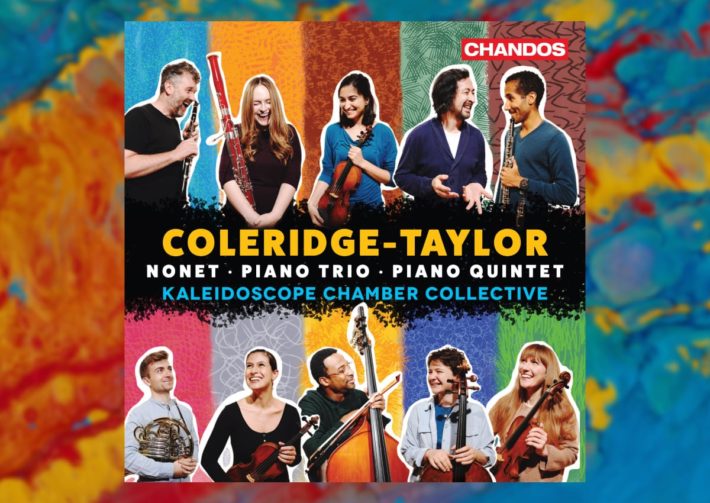English composer Samuel Coleridge-Taylor (1875-1912) gained success and recognition during his lifetime with compositions spanning genres including songs, choral works, orchestral compositions, and chamber music. Though his career was sadly curtailed at the age of 37 by pneumonia, his musical creativity manifested early on. The three works the Kaleidoscope Chamber Collective feature on this disc are chamber works, written in 1893 when Coleridge-Taylor was just 18 and a student at London’s Royal College of Music.
The title of the Op. 2 Nonet, “Gradus ad parnassum,” might sound familiar because of Debussy’s reference in his Children’s Corner but also because it was the title of Johann Fux’s 1725 treatise on counterpoint. For Coleridge-Taylor, the name symbolized a compositional accomplishment and, if one goes by the music, the title is undoubtedly well-earned. The sweeping Allegro Moderato (track 1) transforms a 9-part work into something much bigger: there are moments that sound more orchestral than anything. Coleridge Taylor’s creativity comes through in the changing textures; he uses different instrumental pairings to fuel the shifting character of the work, such as the conversation between brass and piano (1’13”) that transitions to strings and woodwinds. The performers highlight these dynamic relationships, all while adding a sprightly kick to the recurring dotted rhythms. The Andante con moto (track 2) is suave yet romantic, thanks to the lush phrasing from the strings. Meanwhile, the winds add complementary touches of elegance. Though the piano takes more of a supporting role here, it is nonetheless instrumental in weaving the parts together–something pianist Tom Poster does a solid job with throughout.
Related Posts
- Review: “Summertime” – Isata Kanneh-Mason, Piano
- Review: George Walker – Five Piano Sonatas – Steven Beck, Piano
- Review: Florence Price – Symphonies 1 & 3 – Nézet-Séguin
The E minor trio reflects several compositional influences from predecessors but is not without Coleridge-Taylor’s signature urbane style. The strings bring out the Mendelssohnian intricacy of the Moderato (track 5) in fine fashion. What I also liked was the all-around balance of the instruments and the seamless exchange of the spotlight. Listen at 1’25”, and we’ll hear how the cello’s line soars but also how the piano’s accompaniment delivers necessary richness, fluidity, and drive to that melody. The Scherzo (track 6) breaks from the convention of a slow middle movement and Coleridge-Taylor aptly evokes its defining characteristic–humor. By navigating the fine line between elegant and scrappy, the performers capture the personality and in the process show just how much thought and musical control they have. The finale contains a subtle nod to Dvořák by way of a tempo marking that appears in two of his orchestral works. Though just two-and-a-half minutes, the ensemble delivers an enthusiastic and rousing account that doesn’t disappoint.
The performances of the Quintet are few and far between: the liner notes mention how Coleridge-Taylor himself took on the piano part at its 1893 premier but how it remained otherwise untouched until 2001. Quite a shame, as the work has much to offer. The opening Allegro con moto (track 8) has its commanding moments but also muses (gracefully, as always) through different tonalities. Compared to the aforementioned Nonet, the piano does appear to play a more central role here: the vertical, chordal textures give structural presence to the dramatic parts, but the arpeggios we hear on several occasions (i.e. 5’30”) lend a sparkling flourish to the string melodies. Compared to E minor trio Scherzo, the quintet’s (track 10) is more serious and urgent but also more harmonically creative. The G major trio that appears starting at 2’17” offers a lovely contrast to the more robust surrounding material. Here, the strings offer subtle, well-controlled pizzicatos while the piano responds in kind with tasteful staccatos.
Just as in their previous album of American Quintets (2021), the ensemble records in the same venue, Potton Hall. It’s evident that the performers, along with the Chandos sound engineers, demonstrate absolute comfort with the space and acoustics. Mervyn Cooke’s excellent liner notes give generous biographical background; the descriptions of each work avoid pedantic details, but listeners will no doubt find the historical and compositional context helpful and interesting. The final note by the performers adds a nice touch that only confirms the sincerity and passion they demonstrate for the music. A highly recommended listen that will have listeners looking forward to the collective’s future releases.

Coleridge-Taylor – Nonet, Piano Trio, Piano Quintet
Armand Djikoloum – Oboe
Matthew Hunt – Clarinet
Amy Harman – Bassoon
Ben Goldscheider – Horn
Elena Urioste – Violin
Savitri Grier – Violin
Rosalind Ventris – Viola
Laura van der Heijden – Cello
Xavier Foley – Double-bass
Tom Poster – Piano
Chandos, CD CHAN 20242
Related Albums
Read more classical music reviews or visit The Classic Review Amazon store
Follow Us and Comment:
Get our periodic classical music newsletter with our recent reviews, news and beginners guides.
We respect your privacy.









